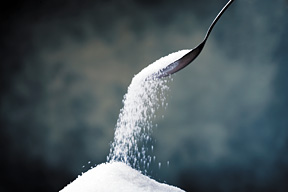Nothing Sweet About Artificial Sugar
By Claudia Anrig, DC
With worldwide obesity rates doubling in the past three decades, is it any surprise that artificial sweeteners have been gaining popularity? Beginning with the creation of saccharin, "sugar substitutes" have become the answer to a dieter's prayer.
Have your cake and eat it, too; it's a dream come true. Or is it? Let's take a closer look.
Aspartame – NutraSweet or Equal
This sugar-substitute was discovered in 1965 by accident while chemist James Schlatter was testing an anti-ulcer drug. Aspartame gained FDA approval in 1981 and was approved for use in carbonated beverages in 1983, where it is most commonly found now as the primary sweetener for most diet sodas.
This chemical accounts for over 75 percent of the adverse reactions to food additives reported to the U.S. Food and Drug Administration and has been linked with serious medical reactions. Yet despite and apparently disregarding these startling statistics, the U.K.'s Scientific Committee on Food (SCF), reviewing more than 500 papers published in the scientific literature between 1988 and 2001 and determined that it was unnecessary to revise its earlier "risk assessment" or the acceptable daily intake of aspartame. The committee contended that 40 milligrams per kilogram of body weight per day is an acceptable daily intake and will pose no risk to an adult. This is the equivalent of 14 cans of the average diet soda if the soft drink manufacturer opts to use the full amount allowable per 12-ounce can.
 The most popular of all sugar substitutes, aspartame is found in more than 6,000 food items on grocery store shelves, many of which you would never expect to contain this chemical: yogurt, chewing gum, energy bars, gelatin snacks and more.
The most popular of all sugar substitutes, aspartame is found in more than 6,000 food items on grocery store shelves, many of which you would never expect to contain this chemical: yogurt, chewing gum, energy bars, gelatin snacks and more.
Children and Aspartame
Of bigger concern is the amount of food items marketed to children that contain aspartame. Obviously the concern of childhood obesity has created a market for "diet" and "sugar free" foods that children would want to consume, but there are dangers to children that far outweigh the dangers to adults.
Aspartame releases aspartate (a neurotransmitter) during digestion. Aspartate is an excitatory amino acid that the brain actually needs and so is readily allowed to cross the blood-brain-barrier (BBB), which is the barrier that protects the brain from harmful chemicals. The problem is that the BBB is not fully developed during childhood and may allow seepage of excess aspartate and glutamate into the brain.
Your child's nervous system is designed to control the concentration of excitatory amino acids. It does this by "pumping the excess back into glial cells, which surround the neurons and supply them with energy," according to Russell Blaylock in Excitotoxins: The Taste that Kills. A compromised or underdeveloped BBB may eventually allow excitotoxins (such as aspartame) to cross, potentially resulting in several adverse reactions such as the nerves being stimulated to fire excessively by the excitotoxins.
The only way for the body to then restore the system requires normal enzymes, which are actually canceled by the phenylalanine and aspartic acid found in aspartame. These "compulsory enzyme reactions" require a healthy energy system, which has basically been compromised by the actual excessive firing of the neurons. In other words, it is a vicious cycle that begins with the intake of aspartame, potentially damaging the neurotransmitters in your child's brain and overworking their nervous and energy systems.

